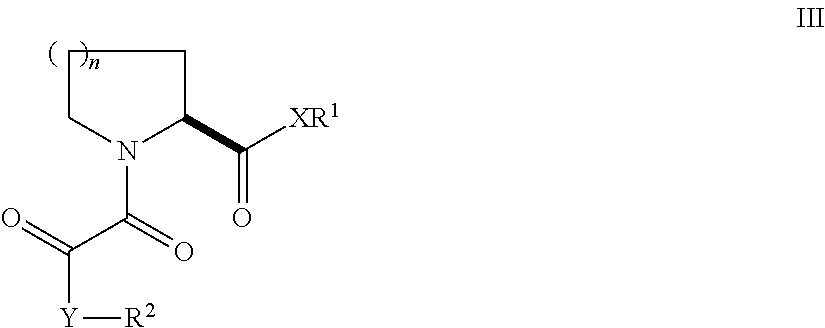Synthetic Multimerizing Agents
- Summary
- Abstract
- Description
- Claims
- Application Information
AI Technical Summary
Benefits of technology
Problems solved by technology
Method used
Image
Examples
example 1
N,N′-Bis[3-(3-((1R)-1-((2S)-(3,3-dimethyl-1,2-dioxopentyl)piperidine-2-carbonyloxy)-3-phenyl)propylphenoxy)propyl]1,4-phenylenediacetamide (31)
[0132]A mixture of 1,4-phenylenediacetic acid (194 mg, 1.0 mmol) and disuccinimidyl carbonate (512 mg, 2.0 mg) in anhydrous acetonitrile (5.0 mL) was treated with pyridine (243 mL, 3.0 mmol). The mixture was stirred at room temperature under nitrogen overnight. The resulting suspension was partitioned between EtOAc (70 mL) and water (50 mL). The organic layer was separated, washed with 1 M Na2CO3, water, 0.5 N HCl, saturated brine, dried (Na2SO4), and concentrated in vacuo to give disuccinimidyl 1,4-phenylenediacetate (144 mg, 37%) as a white solid. 1H NMR (DMSO-d6, 300 MHz) 7.34 (s, 4H), 4.10 (s, 4H), 2.80 (s, 8H).
[0133]A solution of 24 (102 mg, 0.16 mmol) in CH2Cl2 (2.0 mL) was treated with the above activated diester (31 mg, 0.080 mmol) and Et3N (67 mL, 0.48 mmol). The mixture was stirred at room temperature overnight. The resulting clear ...
example 2
N,N′-Bis[3-(3-((1R)-1-((2S)-(3,3-dimethyl-1,2-dioxopentyl)piperidine-2-carbonyloxo)-3-phenyl)propylphenoxy)propyl]suberamide (32)
[0134]Following the same procedure as in Example 1 except replacing suberic acid for 1,4-phenylenediacetic acid, obtained 32 (54 mg, 56%) as a white solid. mp 44-46° C.; 1H NMR (CDCl3, 300 MHz) (single diastereomer, mixture of rotamers) 7.35-6.85 (m, 18H), 6.18 (br. s, 2 H), 5.86 (t, J=5.9 Hz, 2H), 5.39 (d, J=4.9 Hz, 2H), 4.12 (t, J=5.9 Hz, 4H), 3.60-3.40 (m, 6H), 3.28 (td, J=12.6, 2.8 Hz, 2H), 2.70 (m, 4H), 2.47 (d, J=13.8 Hz, 2H), 2.35 (m, 2H), 2.30-2.00 (m, 12H), 1.95-1.70 (m, 14H), 1.55-1.35 (m, 6H), 1.30 (s, 6H), 1.28 (s, 6H), 0.96 (t, J=7.5 Hz, 6H); 13C NMR (CDCl3, 75 MHz) (single diastereomer, mixture of rotamers) 208.3, 170.0, 167.8, 159.3, 141.8, 141.2, 130.2, 128.9, 128.7, 126.5, 119.4, 114.7, 113.0, 66.4, 51.7, 47.1, 44.5, 383, 37.7, 32.8, 32.1, 29.3, 28.7, 26.9, 25.8, 25.3, 23.9, 21.6, 9.1. MS(FAB): (M+Na)+ 1205.
example 3
N,N′-Bis[3-(3-((1R)-1-((2S)-(3,3-dimethyl-1,2-dioxopentyl)piperidine-2-carbonyloxo)-3-phenyl)propylphenoxy)propyl]pyridine-2,6-dicarboxamide (33)
[0135]Following the same procedure as in Example 1 except replacing pyridine-2,6-dicarboxylic acid for 1,4-phenylenediacetic acid, obtained 33 (44 mg, 54%) as a white solid. mp 60-62° C.; 1H NMR (CDCl3, 300 MHz) (single diastereomer, mixture of rotamers) 8.34 (d, J=7.7 Hz, 2H), 8.00 (t, J=7.7 Hz, 1H), 7.99 (br. s, 2H, NHs), 730-6.75 (m, 18H), 5.77 (t, J=5.7 Hz, 2H), 5.30 (d, J=4.8 Hz, 2H), 4.02 (m, 4H), 3.63 (m, 4H), 3.35 (d, J=12.7 Hz, 2H), 3.20 (td, J=12.7, 2.8 Hz, 2H), 2.60 (m, 4H), 2.36 (d, J=13.3 Hz, 2H), 224 (m, 2H), 2.05 (m, 6H), 1.80-1.65 (m, 10H), 1.50 (m, 4H), 1.20 (s, 6H), 1.18 (s, 6H), 0.85 (t, J=7.4 Hz, 6H); 13C NMR (CDCl3, 75 MHz) (single diastereomer, mixture of rotamers) 208.2, 170.1, 167.7, 164.0, 159.3, 149.1, 142.0, 141.2, 139.3, 130.2, 128.9, 128.7, 126.5, 125.4, 119.4, 115.1, 113.2, 107.9, 67.0, 57.1, 51.6, 47.1, 44.5, ...
PUM
| Property | Measurement | Unit |
|---|---|---|
| affinity | aaaaa | aaaaa |
| binding affinities | aaaaa | aaaaa |
Abstract
Description
Claims
Application Information
 Login to View More
Login to View More - R&D
- Intellectual Property
- Life Sciences
- Materials
- Tech Scout
- Unparalleled Data Quality
- Higher Quality Content
- 60% Fewer Hallucinations
Browse by: Latest US Patents, China's latest patents, Technical Efficacy Thesaurus, Application Domain, Technology Topic, Popular Technical Reports.
© 2025 PatSnap. All rights reserved.Legal|Privacy policy|Modern Slavery Act Transparency Statement|Sitemap|About US| Contact US: help@patsnap.com



